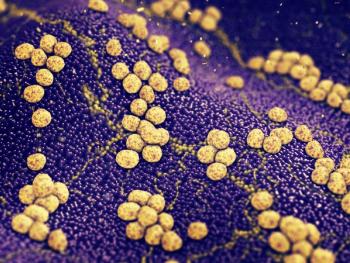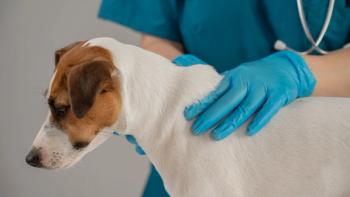
Cutaneous manifestations of serious internal disease (Proceedings)
Virtually all internal diseases will eventually have cutaneous manifestations such as a dull dry coat which sheds easily and is not replaced at a normal rate. In these conditions, the clinical signs of the internal disease occur first and predominate, leading the clinician down the correct diagnostic pathway.
Virtually all internal diseases will eventually have cutaneous manifestations such as a dull dry coat which sheds easily and is not replaced at a normal rate. In these conditions, the clinical signs of the internal disease occur first and predominate, leading the clinician down the correct diagnostic pathway. In the following conditions, the skin signs appear first and may precede the clinical signs of the internal disease by weeks to months.
Atypical Infectious Diseases
Adult-onset of a disease normally seen in puppies
The most common examples of this are generalized demodicosis or papillomavirus infection in the adult dog.
Candidiasis
In humans, candidiasis often follows treatment with antibiotics or some other condition which modifies the cutaneous ecology. Although this happens in animals as well, most cases are due to an underlying severe immunosuppressive condition.
Generalized dermatopyhtosis
Ringworm typically causes multifocal but not generalized lesions in the otherwise normal animals. The Persian cat might be an exception. Widespread-to-generalized disease usually indicates that there is an alteration of the normal epidermal turnover time. Typically, the animal has Cushing's disease but other conditions which slow epidermal turnover need to be considered.
Endocrine or Metabolic Conditions
Acromegal
Typically caused by a pituitary tumor or the administration of a progestational compound. Clinical signs include thickening of the hair coat and skin and widening of the interdental arcade. These dogs are prone to insulin-resistant diabetes.
Testicular tumors
Most problematic are the sertoli cell tumor and the seminoma because of their estrogen secretion. The red cell aplasia or thrombocytopenia induced by the hyperestrogenism often will persist after castration. The odd interstitial cell tumor will secrete testosterone. Testosterone is hepatotoxic in dogs if the dose or duration of exposure is too high/long.
Ovarian tumors
Ovarian tumors can produce estrogens or progesterone. The metabolic consequences of these hormones can persist after surgery.
Hepatocutaneous syndrome
A uncommon condition due to either a cirrhotic liver disease (90% of cases) or a pancreatic glucagonoma. Appearance of skin signs is a very poor prognostic factor with death following in 6 months or less.
Hyperfragility syndrome
A syndrome recognized in the cat associated with cutaneous asthenia (youngsters) or serious metabolic diseases (Cushing's disease, progestational administration or secretion, hepatic lipidosis), or hepatic/pancreatic neoplasia. Cases rarely survive.
Xanthomas
Papular-to-nodular pink-to-yellow lesions typically over pressure points. Cytologically one sees macrophages filled with fat. Clinical evidence of a hyperlipidemic condition
Neoplastic Conditions
Feline digital osteolysis
Rare. Seen with asymptomatic lung tumors.
Feline exfoliative dermatitis
Rare. Generalized exfoliative dermatitis associated with a thymoma. Orange cats can turn white in color. Early surgery will return animal to normal.
Multiple collagenous nevi
Seen in German shepherd dogs predominately but recognized in other breeds. Asymptomatic firm bumps in the skin which are widespread in distribution. No hair loss typically. Use a blade to biopsy as these lesions often are too thick for a punch to get the full thickness of the lesions. Biopsy often comes back as normal skin. Sign of renal or uterine tumor.
Paraneoplastic alopecia
A feline condition which can be seen with hepatic lipidosis but usually is associated with a hepatic or pancreatic tumor. Beyond hair loss, the cats often have a Malassezia dermatitis.
Paraneoplastic pemphigus
The clinical signs (and skin biopsy results) are of pemphigus but the triggering event is typically a lymphoma. These cases have a lymphadenopathy beyond that seen in skin disease and are 'sicker" then the typical dog with an autoimmune skin disease. RULE OUT DRUG INDUCED PEMPHIGUS TOO!!
Cutaneous Flushing
Cutaneous flushing is a result of the dilatation of the superficial capillary network of the skin so that the overlying skin turns various shades of pink-to-red. The flushing can be paroxysmal or persistent. Causes of persistent flushing include drug reaction, cutaneous lymphoma, mastocytosis or mast cell tumor. Paroxysmal flushing can be seen with drug reaction, mastocyosis, mast cell tumor, pheochromcytoma, or the carcinoid syndrome.
Vascultis
Signs of superficial cutaneous vascultis can be due to primary vessel disease (primary vascultis), vascular thrombosis (embolism of bacterial colonies, clumps of tumor cells, etc), or immune-complex deposition on the vessel wall. The latter is most common and is due to a low grade persistent antigenemia. Drug administration is first on the list to rule out followed by infectious agents.
Newsletter
From exam room tips to practice management insights, get trusted veterinary news delivered straight to your inbox—subscribe to dvm360.





